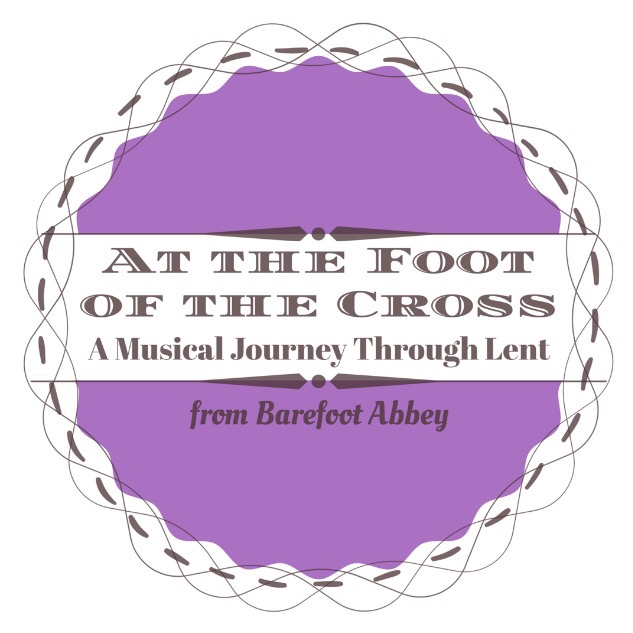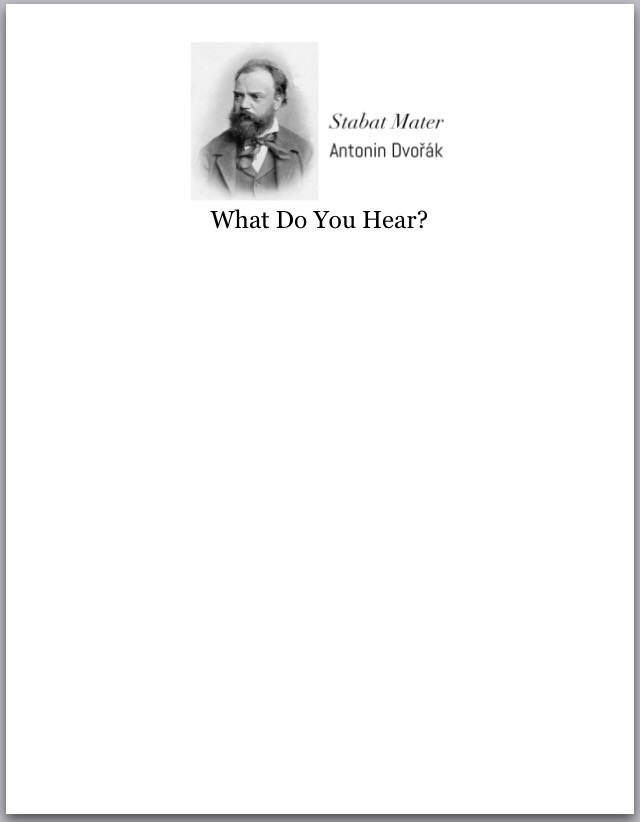We have made it to Week 7 and the glorious festival of Easter is within sight! Thank you so much for accompanying my family on this journey through Lent with Dvořák and Our Lady. I pray it has been a blessing to you and your family! Please let me know in the comments if you have any suggestions or if this devotion has impacted your family positively the last few weeks and you would like to see more seasonal devotions like this one and our Awaiting the Messiah musical Advent calendar in the future.
If you are new here, please join us for our last week by listening to the 10th movement of Dvořák’s Stabat Mater and participate in the music appreciation lesson below. No need to stress out about catching up, the lessons do not build on each other so you can start today! More ideas for employing this Lenten devotion can be found at the Overview post.
For your family’s Good Friday and Black Saturday soundtrack, you can find the whole work here:
Dvořák’s Stabat Mater
The Story of Dvořák in Music and Words is provided below for your family’s free listening.
Week 7
10. “Quando Corpus Morietur” – Quartet and Chorus
Latin Text:
Quando corpus morietur,
fac, ut animae donetur
paradisi gloria. Amen.
English Translation:
While my body here decays,
may my soul Thy goodness praise,
safe in paradise with Thee. Amen.
For our lessons this Lent, we will be using our family’s easy ABC method for listening with purpose. It is a simple three step process that can be used with the whole family and all ages. Your family will be listening to the piece with purpose at least once with specific actions in mind. The whole lesson typically takes around 15 minutes to complete if you include all three steps. It can be expanded based on length of pieces and the extent of conversation. This method is intentionally adaptable to fit all families in hopes that it will aid in fostering a love of music and meaningful connections in your home. Read through the lesson beforehand, then pull out and use what you know will work with your child(ren). Don’t be afraid to include the youngest of children too! My 1 year old daughter and goddaughter just dances around while listening and that is perfect!
Our Easy ABCs for Music Appreciation
Begin by printing the pages at the bottom of this post and gathering everyone together for your family listening time. Our family reads the text and translation then participates in the lesson. This week our family will be doing the lesson as part of our Black Saturday devotions. You may choose the day that works best for your family.
If you have any questions please don’t hesitate to leave a comment. I want these lessons to be as user friendly as possible!
You can share what you like from the following or use it as an easy script:
Our last music lesson for Lent is the tenth and final movement of Dvořák’s Stabat Mater, “Quando Corpus Morietur”. It features a quartet of soloists, four voices, and choir. The text is only half a stanza but Dvořák skilfully stretches the text by alternating the half stanza portions with expanded “Amen” sections. He also incorporates a capella segments throughout for added contrast and drama. This piece has a beginning very similar to the first movement we listened to this Lent with held legato (flowing, smooth) notes by the strings and woodwinds families. Also the motives (musical ideas) of the voices mimic the opening line of the first movement, though with differing text. The lower solo voices (Bass and Alto) introduce the first motive (musical idea) of text, followed by the higher solo voices, then the Choir with the same melody. Dvořák then employs the technique of text repetition at higher and higher pitches (notes) to increase suspense before the first a capella part. The quartet of soloist then sing the half stanza alone before the first “Amen” portion. Here again Dvořák uses the repetition of the text “paradisi gloria” to add tension to the music then take us from the key of b minor to B Major before the climax of the whole Stabat Mater work – the melismatic “Amen” section and last half stanza. “Quando Corpus Morietur” may start with the same somber tone as the first movement, however, like the metamorphasis a caterpilar undergoes to emerge as majestic butterfly, the same musical themes are altered and expanded upon to transform them from a lament of desolation into an anthem of hope and anticipation for Christ’s Resurrection and eternity. The choir leads the “Amen” melismas, where many notes are sung on the same syllable of a word, the “Ah” of Amen. These melismatic runs are reminiscent of Handel’s works composed over 150 years earlier and, with the aid of the tympani drum, build up momentum to the concluding statement of the work, the ultimate prayer of the text simply presented as the second and final a capella section. The gradual ritardando (slowdown) and thinning out of the orchestration toward the brief, dissolving Amen part signal the end of Dvořák’s Stabat Mater.
Now onto the main processes of our Listening ABCs.
A – Attentive Listening
Before you play the piece for the first time, ask your family to close their eyes and listen silently. Ask them to try and get a feeling, picture, or story in their mind of what the music reminds them of. They may remember some of the text translation read earlier. You may read it again now. We really want them to get their imaginations running for this first listening. Ask them to share what they saw in the music. There is no right or wrong answer. This will be continued in Part B.
B – Bodily Movement
Now we’re going to add a bodily movement to help our brains connect our memory and the music. Below is a printable page that your students can use to make a music college of what they head in the music. The piece may be played for a second time at this point. The texture (the way the vocal and instrumental parts all fit together) of this piece has many layers, from the overlapping solo voices throughout to the soaring soprano descant (a higher melody sung above the main melody) over the choir in the first Amen portion. We want to pay special attention to these textures as we now listen. While listening, students may write or draw the instruments they hear, overlapping lines of color for the changing textures of different segments of the music or even an over all impression of the piece connected to the text. The picture may be whatever the children imagines, however detailed or abstract.
C – Conversation
This concluding segment is where we talk about the elements we hear in the music. Each time your family listens with purpose using these ABCs, they will hear and be able to verbalize more and more. Any observation is welcome and should be praised. In this section you may choose to have your family listen to the piece one last time while pointing out the elements of the music they recognize. Your family may also go straight on to the discussion. This is a splendid piece to discuss mood given the contrasting minor key (more sad sounding) and major key (happier sounding) portions as well as the alternation half stanzas of text and “Amen” parts. How did the music make your family feel during certain parts of the piece? Do they feel the music was more effective at eliciting an emotional response during the accompanied or a capella segments? Please share your own thoughts with your family too.
(Just click on the picture to download)


